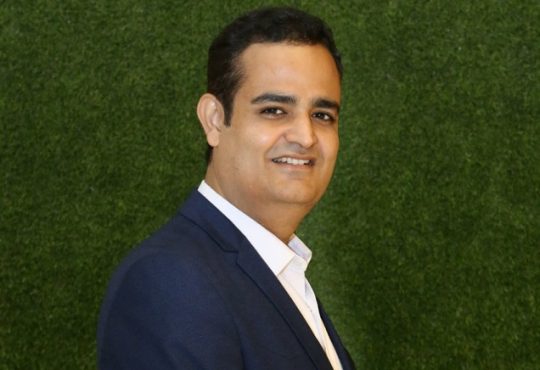
CXOToday has engaged in an exclusive interview with Saarang Ganapathi, COO – Embassy Services Private Limited
Questions on the Role of Facility Management in the Technology Industry
- How does facility management contribute to the growth and success of the Indian technology industry?
Operational Efficiency: FM ensures that all physical resources, including buildings, equipment, assets and utilities, are maintained in optimal condition. This minimizes downtime and operational disruptions, which is critical for tech companies that rely heavily on uninterrupted power, cooling, and network connectivity.
Cost Management: Effective FM helps in reducing operational costs through energy management, predictive maintenance, and efficient use of space. Lower operational costs can be redirected towards research, development, and other strategic initiatives.
Scalability: As tech companies grow, their space and facility requirements change. FM ensures that expansions are managed smoothly, whether through new construction, renovations, or optimizing existing spaces.
Sustainability: Tech companies are increasingly focused on sustainability. FM supports this by implementing green building practices, energy-efficient systems, and waste reduction programs, enhancing the company’s environmental credentials.
Compliance and Risk Management: FM ensures compliance with local regulations and standards, mitigating risks associated with non-compliance, such as fines or shutdowns. This is particularly important in a heavily regulated industry like technology.
- Can you elaborate on how IFM services such as HVAC maintenance, MEP services, and waste management enhance employee experience and productivity in tech companies?
HVAC Maintenance: Properly maintained HVAC systems ensure optimal indoor air quality and comfortable temperatures, which are crucial for employee well-being. Poor air quality and uncomfortable temperatures can lead to health issues and reduced concentration, affecting productivity.
MEP Services: Reliable mechanical, electrical, and plumbing systems are essential for the smooth operation of tech companies. These services ensure that critical infrastructure, such as data centers and labs, function without interruption. Preventive maintenance and timely repairs help avoid unexpected failures that can disrupt work, including regular checks for plumbing fixtures.
Waste Management: Efficient waste management programs create a clean and organized workplace. In tech environments, this often includes managing electronic waste, which can be hazardous if not handled properly. Segregation at the source and employee education are crucial, and FM plays a big part in this. A clean environment reduces health risks, enhances the overall work atmosphere, and contributes to better employee morale and efficiency.
- What role does facility management play in ensuring the health and safety of employees in the technology sector?
Compliance with Health and Safety Regulations: FM ensures that all workplace safety regulations and standards are met, including fire safety, emergency preparedness, and ergonomic standards. This reduces the risk of accidents and injuries.
Emergency Preparedness: FM teams develop and implement emergency response plans, conduct regular drills, and ensure that safety equipment (like fire extinguishers and first aid kits) is readily available and functional. They also help form dedicated teams on each floor to assist with evacuation and ensure a coordinated response during emergencies.
Ergonomics: Implementing ergonomic solutions, such as adjustable workstations and chairs, helps in preventing musculoskeletal disorders. Comfortable and ergonomically designed workspaces are essential for the health and productivity of employees, especially in tech companies where long working hours are a thing.
Questions on Technological Advancements in Facility Management
- How are advancements in automation, data analytics, and AI transforming facility management practices?
Automation: Automation streamlines routine tasks such as HVAC control, lighting, and security systems, reducing human intervention and errors while improving efficiency and response times.
Data Analytics: Real-time data analytics helps in monitoring and optimizing energy usage, predicting maintenance needs, and managing space utilization. This leads to cost savings and better resource allocation.
AI: AI enhances predictive maintenance by analysing data to foresee equipment failures before they occur, thus preventing downtime. AI-driven chatbots and virtual assistants improve service requests and user interactions within facilities.
- Can you provide examples of how smart building technologies are being used to optimize building operations in the tech industry?
IoT Sensors: IoT sensors monitor various parameters like occupancy, temperature, and humidity in real-time, optimizing HVAC systems and lighting to save energy and enhance comfort.
Building Management Systems (BMS): Advanced BMS integrate multiple building systems (HVAC, lighting, security) for centralized control and monitoring, improving operational efficiency and reducing energy consumption.
Smart Lighting: Automated lighting systems adjust based on occupancy and natural light availability, reducing energy usage and enhancing workplace comfort.
- What are the key benefits of using mobile apps and cloud-based software platforms in facility management?
Real-Time Access: Mobile apps provide facility managers with real-time access to building systems and data from anywhere, enhancing responsiveness and decision-making.
Scalability: Cloud-based platforms support scalability, allowing for easy integration of additional buildings or systems as the company grows.
Collaboration and Communication: These tools facilitate better communication and collaboration among facility management teams, service providers, and employees, improving efficiency and service quality.
Data Storage and Security: Cloud platforms offer secure data storage and backup solutions, ensuring that critical information is protected and easily retrievable.
Questions on ESPL’s Approach to Automation and Innovation
- What inspired ESPL to incorporate automation into its facility management services?
ESPL was inspired to incorporate automation into its facility management services to enhance operational efficiency, ensure compliance, and provide superior customer service. By leveraging technology, ESPL aims to streamline routine tasks, reduce human errors, and enable data-driven decision-making. This not only boosts productivity but also supports continuous improvement and innovation within their operations.
Additionally, with the influx of multinational companies setting foot in India, it became crucial for ESPL to offer tech-integrated and ESG-compliant services to stay competitive and expand its business. Embracing automation and going paperless helps ESPL remain up-to-date, attractive to new clients, and aligned with environmental, social, and governance (ESG) standards.
- Can you explain how the Embassy360 app has transformed the management of maintenance requests and issue resolution?
The Embassy360 app has revolutionized maintenance requests and issue resolution by providing a comprehensive helpdesk and ticketing management system. It manages the complete lifecycle of facility management issues with pre-set escalation matrices based on client SLAs. This has significantly reduced turnaround times (TAT) for issue resolution, increased productivity, and empowered site teams to proactively raise and swiftly close tickets, thereby enhancing customer satisfaction.
- How does predictive maintenance, facilitated by sensors and data analytics, enhance the efficiency and reliability of your facility management services?
Predictive maintenance at ESPL uses sensors and data analytics to monitor equipment performance and detect anomalies in real-time. This approach enables proactive maintenance, reducing the risk of unexpected failures and downtime. By predicting when equipment will need maintenance, ESPL can schedule repairs at optimal times, ensuring continuous operation, extending asset lifespan, and reducing maintenance costs.
Questions on Specific Tools and Technologies Implemented by ESPL
- How does the IoT platform at ESPL contribute to sustainable practices and operational efficiency?
The IoT platform at ESPL facilitates efficient monitoring and regulation of asset performance, occupant comfort, and resource consumption, such as energy, water, and fuel. By providing real-time data on footfall and occupancy levels, it enables proactive maintenance and optimization of resource usage. This promotes sustainable practices by minimizing waste and enhancing operational efficiency.
- What are the unique features of the E-Spectrum CRM tool, and how do they enhance facility management operations?
The E-Spectrum CRM tool integrates multiple facility management functions into one platform, offering features such as digital logbooks for MEP and housekeeping checks, inventory management, and advanced analytics. It enhances operations by simplifying task management, ensuring timely maintenance, providing asset abnormality and AMC expiration alerts, and facilitating data-driven decision-making for continuous improvement.
- Can you describe how the Digital Logbook module supports maintenance management and ensures adherence to high standards?
The Digital Logbook module in E-Spectrum digitizes HK and MEP checklists, streamlining supervision and ensuring adherence to high standards. It simplifies task management by ensuring technicians are at the right place at the right time and digitizes maintenance checklists, job cards, and history cards. The module also provides analytics to support maintenance management, enhancing compliance and operational efficiency.
Questions on the Impact of ESPL’s Innovations
- How has implementing technology and automation at ESPL resulted in cost savings for your clients?
Implementing technology and automation at ESPL, including the Embassy Residential App, has led to significant cost savings for clients through:
- Streamlined Operations: Consolidates multiple functions into one platform, reducing administrative overhead and increasing efficiency.
- Enhanced Communication: Facilitates seamless communication, minimizing misunderstandings and delays.
- Efficient Resource Management: Optimizes planning and resource utilization, reducing wastage and expenses.
- Improved Issue Resolution: Ensures quick handling of complaints, reducing downtime and maintenance costs.
- Proactive Management: Enables early detection and resolution of potential problems, avoiding costly repairs.
- Resident Empowerment: Reduces the workload on facility management staff, allowing them to focus on critical tasks.
- How do you foresee the future of facility management evolving with further technological advancements?
The future of facility management will likely see increased integration of AI, IoT, and data analytics, leading to smarter and more proactive management practices. Enhanced automation, real-time monitoring, and predictive maintenance will become standard, improving efficiency and sustainability. The industry will also focus on creating more adaptive and responsive environments, further enhancing the user experience and operational effectiveness.
General Questions on Industry Trends and Future Outlook
- What are the current trends in the facility management industry, especially concerning technological integration?
Current trends in the facility management industry include the widespread adoption of IoT for real-time monitoring, AI for predictive maintenance and data analytics, and mobile and cloud-based solutions for enhanced accessibility and collaboration. Sustainability practices, such as energy management and waste reduction, are also gaining traction, driven by both regulatory requirements and corporate social responsibility.
- How do you stay ahead of the curve in adopting and implementing new technologies in facility management?
Staying ahead in adopting new technologies involves continuous research and development, partnering with technology innovators, and actively participating in industry forums and conferences. ESPL prioritizes investing in training and development for its workforce to ensure they are proficient with the latest tools and technologies. Regularly updating and upgrading systems and processes also ensures that ESPL remains at the forefront of technological integration in facility management.
- What are the biggest challenges and opportunities you see for the facility management industry in the next five years?
The market will soon witness greater demand for quality services that shall abide by the international standards, which could also mean that the smaller unorganised sector will merge with the large players in the market. The market is also expected to mature and people would begin to look at FM as a more holistic services which include all the different verticals such as Housekeeping, Pest Control, Engineering/Techjnical services, Security, Front Office, etc., and clients would prefer to deal with one company rather than smaller individuals that do not provide all the required services under one umbrella. In the future, the growth of various sectors would help shape the FM trajectory in the country. The opportunities are vast so as long as the FM players evolve with the market demand, it will provide employment for millions of individuals in the country in the coming years!
Facility management is not always the first choice for individuals starting their careers. However, with access to skilled manpower, comprehensive training, and effective retention strategies, the field offers substantial opportunities for growth and development








